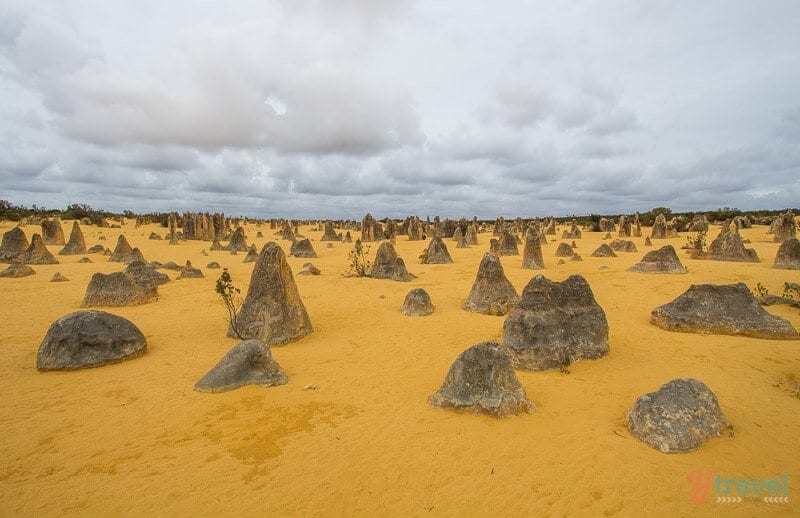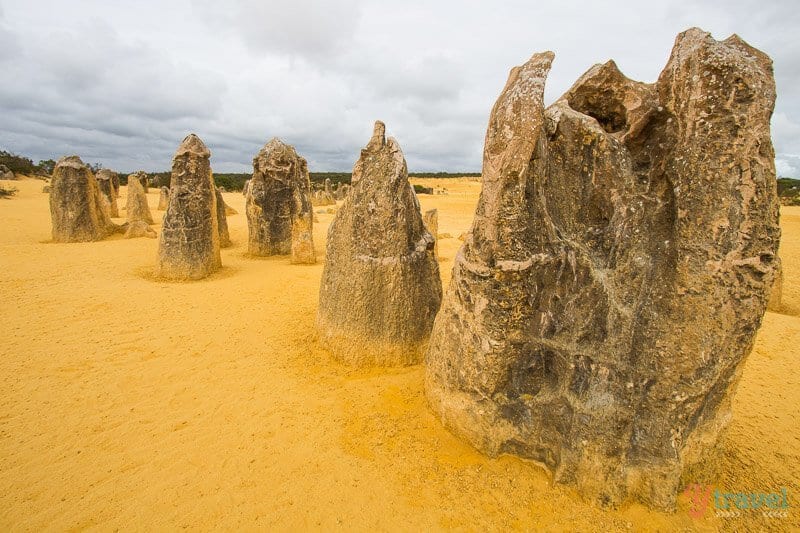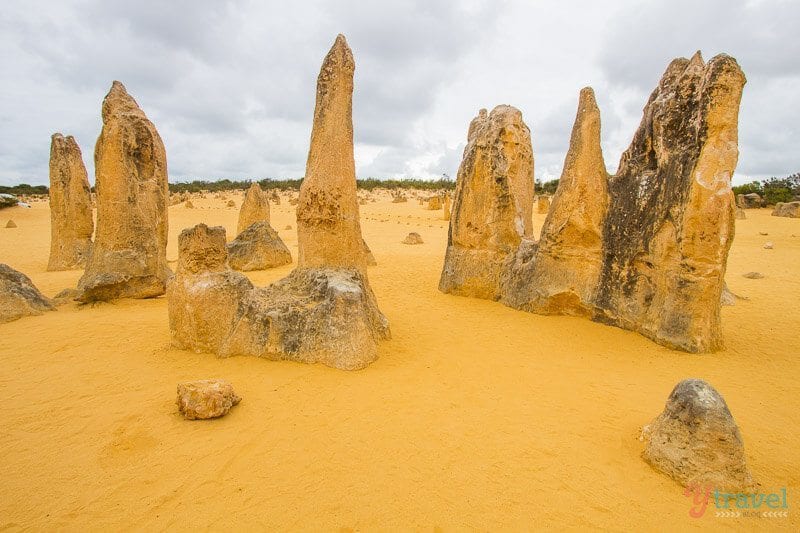This post may contain affiliate links. We may receive a small commission, at no cost to you, if you make a purchase. Read Disclosure.
Western Australia is full of incredible landscapes, but perhaps one of the most special is the ancient limestone formations known as The Pinnacles.
These rock formations are another example of how extraordinarily beautiful this state is.
Formed over 25,000-30,000 years ago, The Pinnacles are the remains of sea shell deposits which stand in unusual pillars.

It is said that after the sea receded, the coastal winds reduced the sand and left the pillars exposed to the elements.
There is no denying that the Pinnacles Desert adds another dimension to this state.
But if you’re thinking of visiting the Pinnacles in Western Australia but not sure how, here is everything you need to know…
Where are The Pinnacles Desert?
The Pinnacles Desert in Western Australia is located in the Nambung National Park just 193 km north of Perth along the Indian Ocean Drive.
To get to The Pinnacles from Perth, you will need to drive 191 km North via State Route 60, which takes roughly 2 hours.
The nearest town is Cervantes, but you will also find accommodation in Jurien Bay which is near to the park. If you need a rental car, check rates and availability from our preferred partner, Discover Cars.
Check out day tours to The Pinnacles from Perth here:
What Are The Pinnacles?

The Pinnacles in Western Australia are weathered rock spires rise out of yellow sand dunes with some standing as high as five metres.
They are geological formations were formed approximately 25,000 years ago after the sea receded and left deposits of sea shells.
In an earlier era, such raw materials were in abundance as there was more sea life.
And over time coastal winds removed the surrounding sand leaving the soft limestone pillars exposed to the elements.
Rainfall caused dissolutional remnants of the tamala limestone to trickle down to the bottom of the sand dunes, which added to the structures.
As well as this, the surrounding sand dunes have many plants and flora, which help protect the dunes from strong winds.

However, when the wind blows, it causes an acidic layer of soil to seep over onto the soil and create a layer of calcrete (a combination of sedimentary rock or hardened deposit of calcium carbonate) to form.
What you see now is a result of a period of extensive solutional weathering and erosion.
You can either walk amongst them (4 kilometres) or you can drive around on a marked track – I chose to walk.
Who found The Pinnacles?

The exact time when the Pinnacles were discovered is still up for debate. The earliest records mentioning the Pinnacles state they were found by Dutch explorers in the 1650s.
The were included in the Nambung National Park area in the 1960s.
FAQs About Visiting The Pinnacles
Here’s what people usually ask us about The Pinnacles…
When is the best time to visit The Pinnacles
The Pinnacles are an amazing site all year round, but the Spring period between August and October are good months to visit as the rest of the Nambung National Park is in bloom this time of year.
I highly recommend you time your visit for early morning or late afternoon, as it can get busy during the middle of the day.

What animals live near The Pinnacles?
As with all national parks in Australia, The Pinnacles is home to an array of Aussie wildlife. You can expect to see some nocturnal animals returning to their shelter if you visit early in the morning.
Animals such as kangaroos, wallabies, emus, possums, snakes, bobtails and lizards and other reptiles call this park home.
You can also visit nearby Hangover Bay which also reaches The Pinnacles zone. If you visit during June to November, you may spot dolphins or humpback whale swimming in the ocean.
How to see The Pinnnacles?

The national park opens every day of the week, all year round, and you can only visit them by car or by tour.
There is a fully sealed road called “Pinnacles Drive” leading up to the site. This road is just off Indian Ocean Drive (Highway 60).
Visitors must pay an entrance fee at the gate. If you have an RV or Caravan, you will need to park at the car park and walk up.

Once you have paid at the gate, you can park up near the Pinnacles Desert Discovery Centre.
From here, you can walk around the site on a viewing boardwalk, and walk up to a lookout point.
The loop around the park is about 4km but it’s all flat.
What to bring to The Pinnacles?
You should make sure to bring a sunhat, sunscreen and plenty of water as it can get warm and sunny around the Pinnacles.
Since the sun reflects off the white limestone of the Pinnacles and lime-rich sand, so bring some sunglasses as well.
If you’re a photographer, you can bring a tripod.
You cannot bring any pets with you to the park, and everything you take, you must bring back with you.
Opening Hours and Entry Fees
The park is open all year round (except Christmas Day), seven days a week, from 9am until 4.30pm.
It costs $15.00 per passenger vehicle (pensioners get a discount) but this allows you to visit the entire national park, not only The Pinnacles.

How long to spend at The Pinnacles?
You don’t need much time here, one hour is enough to enjoy the gorgeous desert landscape. You may want to check out nearby white beaches of Jurien Bay while here.
Or keep driving north to Monkey Mia.
Caz was actually sick when we visited and laid down in the car whilst I walked around taking a few photos.
And you don’t need a hard-core 4WD to visit, any ordinary 2WD is enough if you choose to drive.
You can also join tours from Perth if you don’t have your own vehicle to get to Pinnacles, WA. And you can rent a car here.
Plan Your Trip to Western Australia
If you’re planning to visit other parts of Western Australia, be sure to check out the following resources which may be useful to you…
- Beaches in Western Australia
- Karijini National Park
- Things to do in Exmouth
- Falling in love with Coral Bay
- Things to do in Perth
- Guide to visiting Elephant Rocks and Greens Pool
Need more tips for Western Australia? Check out this post – 50 things to do in Western Australia